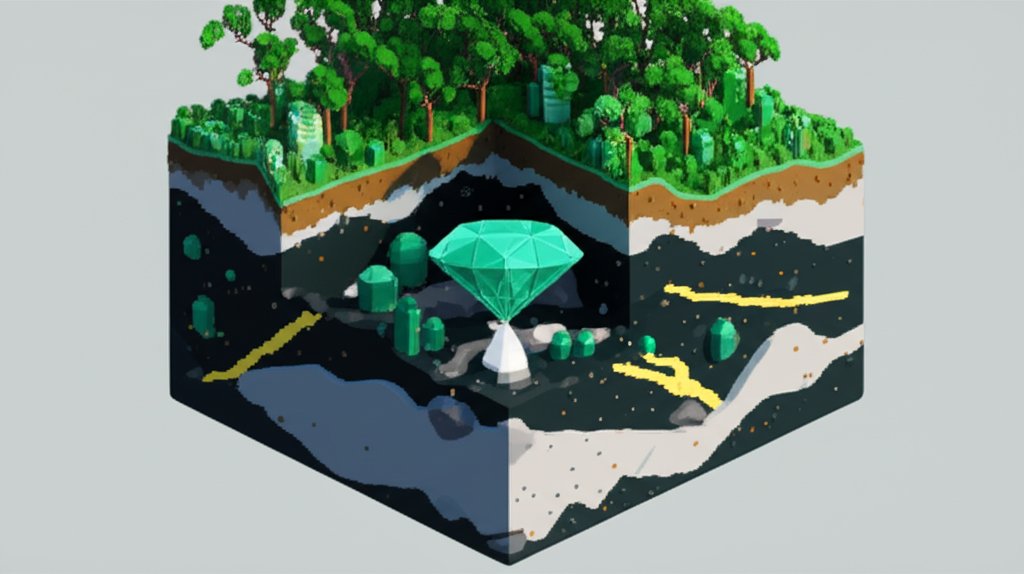Step into a world where lush green hues tell tales of ancient civilizations, royal prestige, and breathtaking natural artistry. Emeralds, the captivating green gemstones, stand as one of the most revered and coveted jewels on Earth. Far more than just beautiful stones, they are living testaments to geological wonder and human fascination, classified among the elite group of precious gemstones.
As we embark on this journey, prepare to uncover fascinating facts about emeralds that will deepen your appreciation for their unique origins, vibrant colors, profound symbolism, and enduring cultural significance. From the depths of ancient mines to the pinnacles of modern luxury, we will explore why the emerald gemstone continues to mesmerize and enchant. Get ready for a comprehensive dive into the verdant heart of these extraordinary treasures, designed to arm you with a world-class understanding of emeralds and outrank all existing content.
The Allure of Emeralds: A Precious Green Gemstone
Emeralds are not merely green rocks; they are the vibrant embodiment of nature’s most exquisite artistry. As one of the ‘Big Three’ colored gemstones (alongside rubies and sapphires), emeralds hold a special place in the hierarchy of precious gemstones, celebrated for their unparalleled charm and depth of color.
More Than Just Green: Defining the Emerald Gemstone
At its core, an emerald gemstone is a variety of the mineral beryl (beryllium aluminum cyclosilicate). What distinguishes an emerald from other beryl varieties, like the pale blue aquamarine, is its signature green color. This vibrant hue is primarily caused by trace amounts of chromium and, sometimes, vanadium within its crystal structure. Gemologists and connoisseurs agree that a true emerald must possess a distinct, rich green color, ranging from bluish-green to pure green, with strong to vivid saturation and a tone that is not too dark or too light. If the color is considered “too light” by experts, it is often classified as simply “green beryl,” making the intensity of its verdant shade a crucial factor in its classification and value.
Birthstone & Symbolism: Enduring Meanings
Emeralds have long been associated with powerful symbolism, making them a popular choice for personal adornment and meaningful gifts. As the traditional birthstone for May, they perfectly capture the essence of spring – renewal, growth, and new beginnings. Historically, emeralds have also been linked to Tuesdays and the vibrant season of spring.
Across cultures, the emerald gemstone symbolizes:
- Love and Fidelity: Associated with the Roman goddess Venus (or Greek Aphrodite), emeralds were believed to strengthen love, promote harmony, and even protect lovers from unfaithfulness, glowing brighter in the presence of true love.
- Hope and Rebirth: Their life-affirming green color connects them to nature’s cycles of regeneration, offering hope and vitality.
- Wisdom and Foresight: Many ancient traditions believed emeralds enhanced intelligence, memory, and aided in clairvoyance, granting wearers insights into the future.
- Healing and Protection: Ancient Egyptians and Romans wore emeralds for their supposed healing properties, believing they could cure various ailments and ward off evil.
From ancient pharaohs to modern-day romantics, the profound symbolism of emeralds continues to captivate and inspire.
Unearthing History: Ancient Facts About Emeralds
The story of emeralds is deeply intertwined with human civilization, stretching back thousands of years. From ancient queens to revered philosophers, these green gemstones have left an indelible mark on history and mythology.
The Pharaohs’ Treasure: Egyptian Origins
Among the most fascinating facts about emeralds is their ancient origin in Egypt. The earliest known emerald mines, located near the Red Sea, date back to at least 330 BC, though some evidence suggests mining as early as 1500 BC. These mines, famously known as Cleopatra’s Mines, supplied much of the ancient world’s emeralds. Queen Cleopatra VII, renowned for her love of luxury, was particularly fond of this precious gemstone, often adorning herself and her palace with them. The Egyptians revered emeralds, believing they possessed protective and healing powers, using them in jewelry, talismans, and even for burial rituals, symbolizing eternal life.
A Name Rooted in Antiquity: From Greek ‘Smaragdus’
The very name ‘emerald’ carries a legacy of ancient appreciation. It derives from the Greek word “smaragdus,” which literally means “green gemstone.” This term eventually evolved through Latin “smaragdus” to Old French “esmeraude,” and finally to the English “emerald.” This etymological journey itself highlights how universally admired this specific shade of green has been throughout history.
Roman Wisdom: Pliny the Elder’s Admiration
The Roman natural philosopher Pliny the Elder, in his monumental work Naturalis Historia (Natural History), eloquently captured the allure of emeralds in the 1st century AD. He remarked, “No color is more delightful in appearance… For whereas the sight is refreshed and restored by gazing upon the green grass, it is refreshed and restored much more by gazing upon the green beryl.” His admiration underscores the profound impact these green gemstones had on even the most scientifically-minded individuals of antiquity, recognizing their unique ability to soothe and captivate the eye.
Global Green Gold: Where Emeralds Are Found
While emeralds have been unearthed in various locations worldwide, certain regions are famed for producing stones of exceptional quality and quantity. The geological conditions necessary for emerald formation are relatively rare, contributing to their status as precious gemstones.
Colombia: The Undisputed Emerald Capital
When discussing facts about emeralds, Colombia invariably takes center stage. This South American nation is widely considered the emerald gemstone capital of the world, responsible for producing over 50% of the globe’s finest emeralds. Colombian emeralds are celebrated for their vivid, intense green color, often described as a “pure” or “grass green” with a slight bluish tint.
The most famous Colombian mines include:
- Muzo: Known for producing some of the deepest, richest green emeralds.
- Chivor: Famous for its slightly yellowish-green emeralds.
- Coscuez: Yields bright, slightly bluish-green stones.
The unique geological processes in Colombia, primarily low-temperature hydrothermal conditions, result in emeralds with exceptional clarity and a characteristic internal glow, often referred to as “fuego” (fire) or “vida” (life).
Other Notable Emerald Sources
While Colombia reigns supreme, other countries also contribute significantly to the world’s supply of emeralds, each offering stones with distinct characteristics:
- Brazil: Produces emeralds with a slightly lighter, often yellowish-green hue. Brazilian emeralds are known for their good clarity and are a significant source.
- Zambia: Famous for producing emeralds with a distinct bluish-green tone, often with fewer inclusions than their Colombian counterparts, renowned for their strong saturation.
- Afghanistan (Panjshir Valley): Known for producing high-quality emeralds with excellent color and clarity, often compared to Colombian stones.
- Pakistan (Swat Valley): Yields beautiful, vivid green emeralds, though often in smaller sizes.
- Madagascar, Russia (Ural Mountains), and the United States (North Carolina) are also minor producers, offering valuable insights into the global distribution of these magnificent green gemstones.
The Jewel’s Heart: Understanding Quality & Value
Unlike many precious gemstones where absolute flawlessness is paramount, emeralds tell a different story. Their unique characteristics contribute to their allure and value. Understanding these nuances is crucial for appreciating the true beauty of an emerald gemstone.
The Four Cs and Beyond: Evaluating an Emerald Gemstone
While the traditional “Four Cs” (Color, Clarity, Cut, Carat Weight) apply to emeralds, their evaluation places a unique emphasis on certain aspects:
- Color (The Most Important C): This is the primary determinant of an emerald’s value. Experts assess its hue (bluish-green to pure green), tone (lightness/darkness), and saturation (intensity). The most prized emeralds exhibit a vivid to strong pure green or bluish-green color of medium to dark tone.
- Clarity (“Jardin”): Unlike diamonds, flawless emeralds are extremely rare. Most emeralds contain visible inclusions, often referred to as the “jardin” (French for “garden”) due to their mossy, garden-like appearance. These inclusions are generally accepted and even celebrated as proof of a natural emerald, giving each stone a unique personality. While too many inclusions can compromise durability, a beautiful jardin can enhance an emerald’s character without significantly detracting from its value, provided it doesn’t heavily impact transparency or brilliance.
- Cut: Due to the prevalence of inclusions and the stone’s brittleness, emeralds are often cut into a specific rectangular or square shape with step facets and beveled corners, known as the “emerald cut.” This cut not only maximizes the stone’s color and brilliance but also protects it from mechanical stress, minimizing chipping. Other cuts, like cabochons (smooth, rounded), are also popular for stones with many inclusions.
- Carat Weight: As with all gemstones, larger emeralds are rarer and command higher prices per carat, especially those with exceptional color and clarity.
“Jardin”: Embracing Natural Inclusions
The “jardin” is perhaps one of the most distinctive facts about emeralds. These internal features – which can include tiny mineral crystals, gas bubbles, or internal fractures – are often considered natural fingerprints that verify a stone’s authenticity and tell its geological story. Rather than pure “flaws,” in emeralds, a well-distributed jardin can be aesthetically pleasing, enhancing the gemstone’s soft, velvety appearance and glow. It’s a testament to the fact that perfection in nature often lies in its unique imperfections.
Durability & Care: Mohs Hardness and Brittleness
Emeralds rate 7.5 to 8 on the Mohs scale of mineral hardness, making them relatively durable for jewelry. However, this hardness is somewhat deceptive because the natural inclusions (jardin) can make emeralds more brittle and susceptible to chipping or breaking than other gemstones of similar hardness.
Proper care is essential for an emerald gemstone:
- Cleaning: Use warm, soapy water and a soft brush. Avoid ultrasonic cleaners, which can cause vibrations that exacerbate existing fractures or loosen pavé settings. Steam cleaners should also be avoided.
- Setting: Due to their brittleness, emeralds are often best protected in bezel or semi-bezel settings, or in designs where the stone is less exposed to impact.
- Treatments: Many emeralds are treated with oil or resin fillers to improve their clarity and conceal surface-reaching fractures. This is a common and accepted practice, but such treatments require care, as they can sometimes degrade over time or with improper cleaning. Always ask for a reputable gemological report to understand any treatments applied.
Distinguishing Green Gemstones: Emeralds and Their Cousins
While emeralds are undeniably the most famous of the green gemstones, they are not the only ones. Understanding what sets emeralds apart from other beautiful green minerals is key to truly appreciating their unique status.
Emerald vs. Green Beryl: The Color Line
As discussed, the line between emerald and green beryl can be fine. Both are varieties of the mineral beryl. The crucial distinction lies in the color’s saturation and the presence of chromium and/or vanadium. A green beryl gemstone will be lighter in tone or less saturated in color than what is considered a true emerald. Gemological labs use strict criteria to make this classification, impacting the stone’s market value significantly. For example, a light green beryl with insufficient color intensity would not be recognized as an emerald, even if it has the same mineral composition.
Other Notable Green Gemstones
The world of green gemstones is rich and diverse, offering a spectrum of hues and properties. While beautiful, none quite capture the unique vibrancy and historical gravitas of the emerald. Here are a few prominent examples:
- Peridot: Known for its distinct yellowish-green, “olivine” color. Peridot is gem-quality olivine and typically softer than emeralds (6.5-7 on Mohs scale) and forms under different geological conditions.
- Tsavorite Garnet: A vibrant green garnet that can rival emeralds in color, sometimes even surpassing them in brilliance. Tsavorites are typically more durable (7-7.5 on Mohs scale) and generally much cleaner than emeralds, with fewer inclusions.
- Green Tourmaline: Found in a wide range of green shades, from light mint green to deep forest green. Green tourmalines are durable (7-7.5 on Mohs scale) and often cleaner than emeralds, but typically lack the specific spectral nuances that define an emerald’s green.
- Chrome Diopside: An intense, often vibrant green gemstone, sometimes mistaken for emerald due to its strong color. However, it is a softer stone (5-6 on Mohs scale) and can be less durable for everyday wear.
- Demantoid Garnet: Another stunning green garnet, highly prized for its exceptional fire and brilliance, often exhibiting a “horsetail” inclusion pattern. Its green hue can be bright, but distinct from an emerald’s.
- Jade (Nephrite and Jadeite): These stones are known for their opaque to translucent greens, often with a unique waxy luster. While historically significant, especially in East Asian cultures, their appearance and mineral structure are quite different from transparent emeralds.
Each of these green gemstones holds its own beauty and value, but the emerald gemstone remains in a league of its own, distinguished by its unique color, geological formation, and unparalleled historical legacy as a true precious gemstone.
Conclusion: The Everlasting Charm of Emeralds

From the ancient mines of Egypt to the vibrant markets of Colombia, emeralds have consistently captured the human imagination, standing tall as one of the most captivating and highly prized precious gemstones. Their rich green hues, born from geological wonders and infused with chromium and vanadium, are a testament to nature’s artistry.
We’ve delved into fascinating facts about emeralds, explored their deep historical roots, profound symbolism, and the unique characteristics that define their value – from the coveted “jardin” inclusions to the protective “emerald cut.” Distinguishing them from other green gemstones, we understand why the emerald gemstone remains synonymous with luxury, renewal, and timeless beauty.
Owning or admiring an emerald is more than just appreciating a stone; it’s connecting with millennia of history, myth, and natural splendor. These vibrant gems continue to inspire awe and devotion, securing their place as enduring symbols of life, love, and growth in our world.
FAQ: Your Top Questions About Emeralds Answered

Q1: What makes an emerald a “precious gemstone”?
A: Emeralds are classified as precious gemstones due to their rarity, exceptional beauty (especially their unique green color), historical significance, and high demand in the global market. Only a few gemstones like diamonds, rubies, and sapphires share this prestigious classification.
Q2: How does an emerald get its distinctive green color?
A: The vibrant green color of an emerald gemstone comes from trace amounts of chromium and/or vanadium that are present during its formation within the mineral beryl. The exact concentration and combination of these elements determine the specific shade and intensity of the green.
Q3: Are all green beryl gemstones considered emeralds?
A: No. While emeralds are a variety of the mineral beryl, not all green beryl is classified as emerald. Gem experts and laboratories typically classify a stone as an emerald only if its green color is sufficiently dark and saturated. Lighter or less vibrant green beryl is simply termed “green beryl” and generally holds less value than a true emerald.
Q4: What is the “jardin” in an emerald?
A: “Jardin” is a French term meaning “garden,” used to describe the characteristic inclusions (internal features like tiny crystals, gas bubbles, or fractures) found within most emeralds. Unlike many other precious gemstones where inclusions significantly reduce value, the “jardin” in emeralds is often accepted and can even enhance their unique character, providing natural proof of authenticity.
Q5: Which country is known for producing the best emeralds?
A: Colombia is widely regarded as the emerald gemstone capital of the world, producing over 50% of the world’s finest emeralds. Colombian emeralds are highly valued for their exceptional quality, vivid green color, and unique internal glow.
Q6: What does the emerald gemstone symbolize?
A: Emeralds symbolize renewal, hope, growth, love, fidelity, and wisdom. They are also traditionally associated with healing properties, protection, and enhancing foresight or clairvoyance. As the May birthstone, they represent spring and new beginnings.
Q7: How should I care for my emerald jewelry?
A: Due to their natural inclusions and relative brittleness, emeralds require careful handling. Clean them with warm, soapy water and a soft brush; avoid ultrasonic and steam cleaners. Store emerald jewelry separately to prevent scratching, and have settings checked regularly by a professional. Be aware that many emeralds are clarity-enhanced with oils or resins, which can be affected by harsh chemicals.










